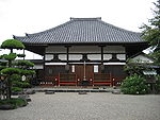
Asuka-dera
Encyclopedia

Asuka, Nara
is a village located in Takaichi District, Nara, Japan.As of September 1, 2007, the village has an estimated population of 6,146 and a density of 255.23 persons per km². The total area is 24.08 km².Asuka is the land where ancient palaces were located...
, Nara
Nara Prefecture
is a prefecture in the Kansai region on Honshū Island, Japan. The capital is the city of Nara.-History:The present-day Nara Prefecture was created in 1887, making it independent of Osaka Prefecture....
. Asuka-dera is regarded as one of the oldest in Japan.
Temple complex
A number of records refer to the origin of the temple, such as the Nihongi and Fusō-ryakuki. The original buildings of what was then called Hōkō-ji were constructed in 588, shortly after the introduction of Buddhism from Baekje, one of the three principal states on the Korean peninsula, according to various sources including Buddhism in JapanBuddhism in Japan
The history of Buddhism in Japan can be roughly divided into three periods, namely the Nara period , the Heian period and the post-Heian period . Each period saw the introduction of new doctrines and upheavals in existing schools...
.
Following the transfer of the capital from Asuka
Asuka, Nara
is a village located in Takaichi District, Nara, Japan.As of September 1, 2007, the village has an estimated population of 6,146 and a density of 255.23 persons per km². The total area is 24.08 km².Asuka is the land where ancient palaces were located...
to Heijō-kyō
Heijo-kyo
Heijō-kyō , was the capital city of Japan during most of the Nara period, from 710–40 and again from 745–84. The Palace site is a listed UNESCO World Heritage together with other places in the city of Nara Heijō-kyō (平城京, also Heizei-kyō, sometimes Nara no miyako), was the capital city of Japan...
(now Nara city
Nara, Nara
is the capital city of Nara Prefecture in the Kansai region of Japan. The city occupies the northern part of Nara Prefecture, directly bordering Kyoto Prefecture...
), the buildings of Asuka-dera were also removed from the original site in Asuka
Asuka
Asuka is a Japanese personal, family and place name derived from Ashuku nyorai, the Japanese name for Akshobhya, one of the Five Wisdom Buddhas.-Places:...
to Nara
Nara, Nara
is the capital city of Nara Prefecture in the Kansai region of Japan. The city occupies the northern part of Nara Prefecture, directly bordering Kyoto Prefecture...
in 718 CE, and developped into a huge temple under the name of Gangō-ji
Gango-ji
is an ancient Buddhist temple, that was once one of the powerful Nanto Shichi Daiji, in Nara, Japan.-History:The original foundation of the temple was by Soga no Umako in Asuka, as Asuka-dera...
. The original site of the Hōkō-ji was also maintained as a temple which survives into modern times.
The main object of worship at Asuka-dera is the bronze Great Buddha, which said to be made by Kuratsukuri no Tori
Tori Busshi
Tori Busshi was a Japanese sculptor active in the late 6th and early 7th century. He was from the Kuratsukuri clan, and his full title was Shiba no Kuratsukuri-be no Obito Tori Busshi ; Busshi is a title meaning "the maker of Buddhist images"...
in the early seventh century. The statue is a designated an Important Cultural Property
Important Cultural Properties of Japan
The term is often shortened into just are items officially already classified as Tangible Cultural Properties of Japan by the Japanese Agency for Cultural Affairs and judged to be of particular importance to the Japanese people....
.
See also
- Gangō-jiGango-jiis an ancient Buddhist temple, that was once one of the powerful Nanto Shichi Daiji, in Nara, Japan.-History:The original foundation of the temple was by Soga no Umako in Asuka, as Asuka-dera...
- For an explanation of terms concerning Japanese Buddhism, Japanese Buddhist art, and Japanese Buddhist temple architecture, see the Glossary of Japanese BuddhismGlossary of Japanese BuddhismThis is the glossary of Japanese Buddhism, including major terms the casual reader might find useful in understanding articles on the subject. Words followed by an asterisk are illustrated by an image in one of the photo galleries...
.

